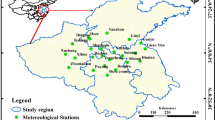Abstract
In this study, changes in climatological conditions around the Korean Peninsula are estimated quantitatively using various types of high order statistical analyses. The temperature data collected from Incheon station have been analyzed for the assessment of the climate variation. According to our analysis, the climate changes observed over the Korean Peninsula for the last century are similar to the global observational data in many respects. First of all, the warming trend [+1.5°C (100 yr)−1] and the overall evolving pattern throughout the century are quite similar to each other. The temperature change in the Korean Peninsula is about two to three times larger than that of the global scale which may partially be ascribed to the influence of urbanization at mid and high latitudes. In this work, a new Winter Monsoon Index (WMI) is suggested based on the European continental scale circulation index (EU1) pattern. Our WMI is defined as the normalized sea level pressure (SLP) difference in the winter period between the centers of the East Sea and west of Lake Baikal in Siberia, the two eastern centers of the EU1 action patterns. A strong similarity is found between the time series of the WMI and surface air temperature at Incheon. The WMI has decreased gradually since the 1920s but has shifted to a rapid increasing trend in the last two decades; it was in fact accompanied by a weakening of the Siberian High and a decreasing of the northerly during winter. Our findings of the close correlations between the surface air temperature at Incheon and the WMI strongly indicate that our newly suggested index is unique and can be used as an efficient tool to predict climate variability in Korea.
Similar content being viewed by others
References
Ahn, J. B., and J. Y. Park, 2000: A study on a statistical long-term prediction model using global sea-surface temperature anomalies.Journal of the Korean Meteorological Society,36(2), 179–188.
Barnston, A. G., and R. E. Livezey, 1987: Classification, seasonality and persistence of low-frequency atmospheric circulation patterns.Mon. Wea. Rev.,115, 1083–1126.
Cha, E. J., J. G. Jhun, and H. S. Chung, 1999: A study on characteristics of climate in South Korea for El Niño/La Niña years.Journal of the Korean Meteorological Society,35(1), 98–117. (in Korean).
Drake, F., 2000:Global Warming, The Science of Climate Change. Arnold, London, 267pp.
IPCC, 1996:Climate Change 1995: The science of C+limate Change. J. T. Houghton et al., Eds., Cambridge University Press, Cambridge, 584pp.
IPCC, 2002:Climate Change 2001: The Scientific Basis. J. T. Houghton et al., Eds., Cambridge University Press, Cambridge, United Kingdom, and New York, NY, USA, 572pp.
Kang, I. S., 1998: Relationship between El-Niño and Korean climate variability.Journal of the Korean Meteorological Society,34(3), 390–396. (in Korean).
Lau, W. K., 1998: Climate system approach to studies of the Asian summer monsoon.Proc. Intern. Conf. on Monsoon and Hydrologic Cycle, Kyongju, Korea, 15.
Mann, M. E., and J. Park, 1996: Joint spatiotemporal modes of surface temperature and sea level pressure variability in the Northern Hemisphere during the last century.Bulletin of the American Meteorological Society,9, 2137–2162.
Park, Y. H., and L. Gamberoni, 1995: Large-scale circulation and its variability in the South Indian Ocean from TOPEX/POSEIDON altimetry.J. Geophys. Res.,100, 24911–24929.
Park, W. S., and I. S. Oh, 2000: Interannual and interdecadal variations of sea surface temperature in the East Asian Marginal Seas.Progress in Oceanography,47, 191–204.
Ruddiman, W. F., 2000:Earth’s Climate—Past and Future. W. H. Freeman and Company, New York, 465pp.
Watanabe, T., K. Hanawa, and Y. Toba, 1987: Analysis of year-to-year variation of water temperature along the coast of the Japan Sea.Progress in Oceanography,17, 337–357.
Webster, P. J., and S. Yang, 1992: Monsoon and ENSO: Selectively interactive systems.Quart. J. Roy. Meteor. Soc.,118, 877–925.
Author information
Authors and Affiliations
Corresponding author
Rights and permissions
About this article
Cite this article
Youn, YH. The climate variabilities of air temperature around the Korean Peninsula. Adv. Atmos. Sci. 22, 575–584 (2005). https://doi.org/10.1007/BF02918489
Received:
Revised:
Issue Date:
DOI: https://doi.org/10.1007/BF02918489




